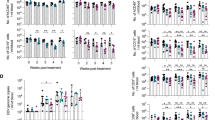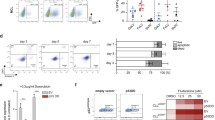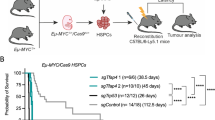Abstract
Primary effusion lymphoma (PEL) is a lymphoproliferative disease of B-cell origin that is associated with HHV-8 infection. PEL cells harbor a non-B, non-T phenotype and lack significant surface immunoglobulin (Ig) expression, a characteristic that has not been fully explained. In the present study, we demonstrate that PEL cells constitutively express interferon regulatory factor (IRF)-4, a transcription factor that regulates the activity of the immunoglobulin light-chain enhancer elements λB and κE3′ through binding to a composite Ets-IRF site. IRF-4 activity requires its physical interaction with PU.1, an Ets family member involved in the activation of genes essential for B-cell development. However, in PEL-derived B-cell lines, PU.1 expression was completely abrogated; expression of the B cell specific transcription factor Oct-2, which is known to regulate PU.1 expression, was also abolished. Moreover, the B-cell-specific coactivator of octamer factors, BOB-1/OcaB, was expressed at very decreased levels in PEL cells. Ectopic expression of Oct-2 was able to fully restore PU.1 promoter activity in the PEL cell line BCBL-1, while PU.1 expression also reconstituted the activity of the λB Ets-IRF site. In addition, protein levels of BSAP/Pax-5 and IRF-8/ICSBP were undetectable in PEL cells. The pattern of transcription factor ablation observed in PEL was found to be comparable to that observed in classical Hodgkin's disease-derived cell lines, which also lack B-cell-specific surface markers. These observations indicate that disruption of the B-cell-specific transcriptional program is likely to contribute to the incomplete B-cell phenotype characteristic of PEL cells.
This is a preview of subscription content, access via your institution
Access options
Subscribe to this journal
Receive 50 print issues and online access
$259.00 per year
only $5.18 per issue
Buy this article
- Purchase on Springer Link
- Instant access to full article PDF
Prices may be subject to local taxes which are calculated during checkout







Similar content being viewed by others
References
Brass AL, Kehrli E, Eisenbeis CF, Storb U and Singh H . (1996). Genes Dev., 10, 2335–2347.
Brass AL, Zhu AQ and Singh H . (1999). EMBO J., 18, 977–991.
Carbone A, Cilia AM, Gloghini A, Capello D, Fassone L, Perin T, Rossi D, Canzonieri V, De Paoli P, Vaccher E, Tirelli U, Volpe R and Gaidano G . (2000a). Leukemia, 14, 1301–1309.
Carbone A, Gloghini A, Cozzi MR, Capello D, Steffan A, Monini P, De Marco L and Gaidano G . (2000b). Br. J. Haematol., 111, 247–257.
Carbone A, Gloghini A, Larocca LM, Capello D, Pierconti F, Canzonieri V, Tirelli U, Dalla-Favera R and Gaidano G . (2001). Blood, 97, 744–751.
Cesarman E, Chang Y, Moore PS, Said JW and Knowles DM . (1995). N. Engl. J. Med., 332, 1186–1191.
Chan WC . (2001). Hematol. Oncol., 19, 1–17.
Chang Y, Cesarman E, Pessin MS, Lee F, Culpepper J, Knowles DM and Moore PS . (1994). Science, 266, 1865–1869.
Chen H, Zhang P, Radomska HS, Hetherington CJ, Zhang DE and Tenen DG . (1996). J. Biol. Chem., 271, 15743–15752.
Corcoran LM, Karvelas M, Nossal GJ, Ye ZS, Jacks T and Baltimore D . (1993). Genes Dev., 7, 570–582.
DeKoter RP and Singh H . (2000). Science, 288, 1439–1441.
Dolcetti R, Boiocchi M, Gloghini A and Carbone A . (2001). Eur. J. Cancer, 37, 1276–1287.
Drexler HG . (1993). Leuk. Lymphoma, 9, 1–25.
Drexler HG, Uphoff CC, Gaidano G and Carbone A . (1998). Leukemia, 12, 1507–1517.
Ehlin-Henriksson B, Manneborg-Sandlund A and Klein G . (1987). Int. J. Cancer, 39, 211–218.
Eisenbeis CF, Singh H and Storb U . (1993). Mol. Cell Biol., 13, 6452–6461.
Eisenbeis CF, Singh H and Storb U . (1995). Genes Dev., 9, 1377–1387.
Falini B, Fizzotti M, Pucciarini A, Bigerna B, Marafioti T, Gambacorta M, Pacini R, Alunni C, Natali-Tanci L, Ugolini B, Sebastiani C, Cattoretti G, Pileri S, Dalla-Favera R and Stein H . (2000). Blood, 95, 2084–2092.
Feldhaus AL, Mbangkollo D, Arvin KL, Klug CA and Singh H . (1992). Mol. Cell Biol., 12, 1126–1133.
Gaidano G, Carbone A, Pastore C, Capello D, Migliazza A, Gloghini A, Roncella S, Ferrarini M, Saglio G and Dalla-Favera R . (1997). Blood, 89, 3755–3762.
Gstaiger M, Knoepfel L, Georgiev O, Schaffner W and Hovens CM . (1995). Nature, 373, 360–362.
Hecht JL and Aster JC . (2000). J. Clin. Oncol., 18, 3707 3721.
Hertel CB, Zhou XG, Hamilton-Dutoit SJ and Junker S . (2002). Oncogene, 21, 4908–4920.
Himmelmann A, Riva A, Wilson GL, Lucas BP, Thevenin C and Kehrl JH . (1997). Blood, 90, 3984–3995.
Junker S, Pedersen S, Schreiber E and Matthias P . (1990). Cell, 61, 467–474.
Lieberman SA, Hines MD, Bergsagel PL, Kuehl WM and Eckhardt LA . (1993). J. Immunol., 151, 2588–2600.
Mamane Y, Grandvaux N, Hernandez E, Sharma S, Innocente SA, Lee JM, Azimi N, Lin R and Hiscott J . (2002a). Oncogene, 21, 6751–6765.
Mamane Y, Sharma S, Grandvaux N, Hernandez E and Hiscott J . (2002b). J. Interferon Cytokine Res., 22, 135–143.
Marecki S and Fenton MJ . (2002). J. Interferon Cytokine Res., 22, 121–133.
Matolcsy A, Nador RG, Cesarman E and Knowles DM . (1998). Am. J. Pathol., 153, 1609–1614.
Muller S, Sideras P, Smith CI and Xanthopoulos KG . (1996). Oncogene, 13, 1955–1964.
Nador RG, Cesarman E, Chadburn A, Dawson DB, Ansari MQ, Sald J and Knowles DM . (1996). Blood, 88, 645–656.
Nelsen B, Tian G, Erman B, Gregoire J, Maki R, Graves B and Sen R . (1993). Science, 261, 82–86.
Omori SA and Wall R . (1993). Proc. Natl. Acad. Sci. USA, 90, 11723–11727.
Osborn L, Kunkel S and Nabel GJ . (1989). Proc. Natl. Acad. Sci. USA, 86, 2336–2340.
Pernis AB . (2002). J. Interferon Cytokine Res., 22, 111–120.
Pongubala JM, Nagulapalli S, Klemsz MJ, McKercher SR, Maki RA and Atchison ML . (1992). Mol. Cell Biol., 12, 368–378.
Radomska HS, Shen CP, Kadesch T and Eckhardt LA . (1994). Immunity, 1, 623–634.
Rao E, Dang W, Tian G and Sen R . (1997). J. Biol. Chem., 272, 6722–6732.
Re D, Muschen M, Ahmadi T, Wickenhauser C, Staratschek-Jox A, Holtick U, Diehl V and Wolf J . (2001). Cancer Res., 61, 2080–2084.
Reya T and Grosschedl R . (1998). Curr. Opin. Immunol., 10, 158–165.
Schubart K, Massa S, Schubart D, Corcoran LM, Rolink AG and Matthias P . (2001). Nat. Immunol., 2, 69–74.
Scott EW, Simon MC, Anastasi J and Singh H . (1994). Science, 265, 1573–1577.
Servant MJ, ten Oever B, LePage C, Conti L, Gessani S, Julkunen I, Lin R and Hiscott J . (2001). J. Biol. Chem., 276, 355–363.
Sharif MN, Radomska HS, Miller DM and Eckhardt LA . (2001). J. Immunol., 167, 4421–4429.
Sharma S, Grandvaux N, Mamane Y, Genin P, Azimi N, Waldmann T and Hiscott J . (2002). J. Immunol., 169, 3120–3130.
Shin MK and Koshland ME . (1993). Genes Dev., 7, 2006–2015.
Singh H . (1994). Immunol. Res., 13, 280–290.
Stein H, Marafioti T, Foss HD, Laumen H, Hummel M, Anagnostopoulos I, Wirth T, Demel G and Falini B . (2001). Blood, 97, 496–501.
Strubin M, Newell JW and Matthias P . (1995). Cell, 80, 497–506.
Torlakovic E, Tierens A, Dang HD and Delabie J . (2001). Am. J. Pathol., 159, 1807–1814.
Acknowledgements
We gratefully acknowledge gifts of Oct-1 and Oct-2 expression vectors as well as murine PU.1 promoter luciferase reporter constructs from Dr Daniel G Tenen (Harvard University); the B4-TKCAT reporter construct from Dr Harinder Singh (University of Chicago) as well as the PU.1 expression vector from Dr Matthew Fenton (Boston University). We extend our gratitude to Dr Antonino Carbone for his kind gift of the PEL cell line CRO-AP6 and to Dr Sigrun Smola for her kind gift of Burkitt's lymphoma and Hodgking's lymphoma cell lines used in this study. Many thanks to Maria Ricci and to the members of the Molecular Oncology Group, Lady Davis Institute, McGill University, for their helpful discussion and technical assistance. This work was supported by Grants MOP42562 from the Canadian Institutes of Health Research.
Author information
Authors and Affiliations
Corresponding author
Rights and permissions
About this article
Cite this article
Arguello, M., Sgarbanti, M., Hernandez, E. et al. Disruption of the B-cell specific transcriptional program in HHV-8 associated primary effusion lymphoma cell lines. Oncogene 22, 964–973 (2003). https://doi.org/10.1038/sj.onc.1206270
Received:
Revised:
Accepted:
Published:
Issue Date:
DOI: https://doi.org/10.1038/sj.onc.1206270
Keywords
This article is cited by
-
Mechanism and therapeutic implications of pomalidomide-induced immune surface marker upregulation in EBV-positive lymphomas
Scientific Reports (2023)
-
Restoring PU.1 induces apoptosis and modulates viral transactivation via interferon-stimulated genes in primary effusion lymphoma
Oncogene (2017)
-
IRF4 and IRF8: governing the virtues of B lymphocytes
Frontiers in Biology (2014)
-
Intrinsic inhibition of transcription factor E2A by HLH proteins ABF-1 and Id2 mediates reprogramming of neoplastic B cells in Hodgkin lymphoma
Nature Immunology (2006)
-
Epigenetic mechanisms do not control viral latency III in primary effusion lymphoma cells infected with a recombinant Epstein–Barr virus
Leukemia (2005)



